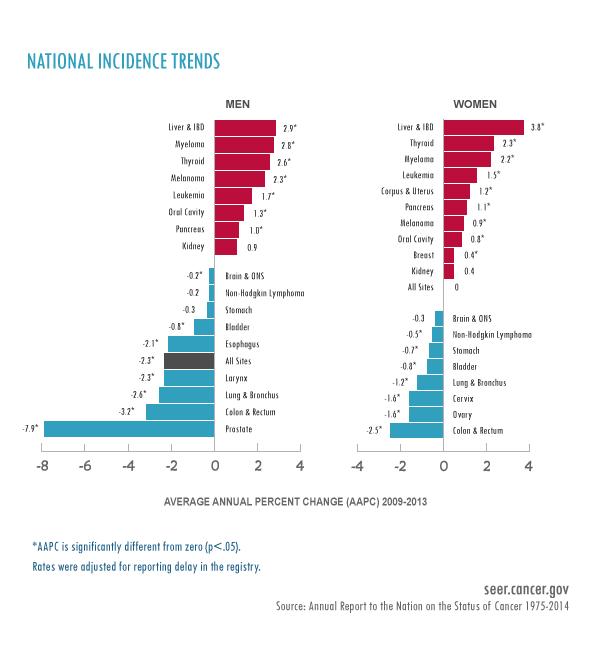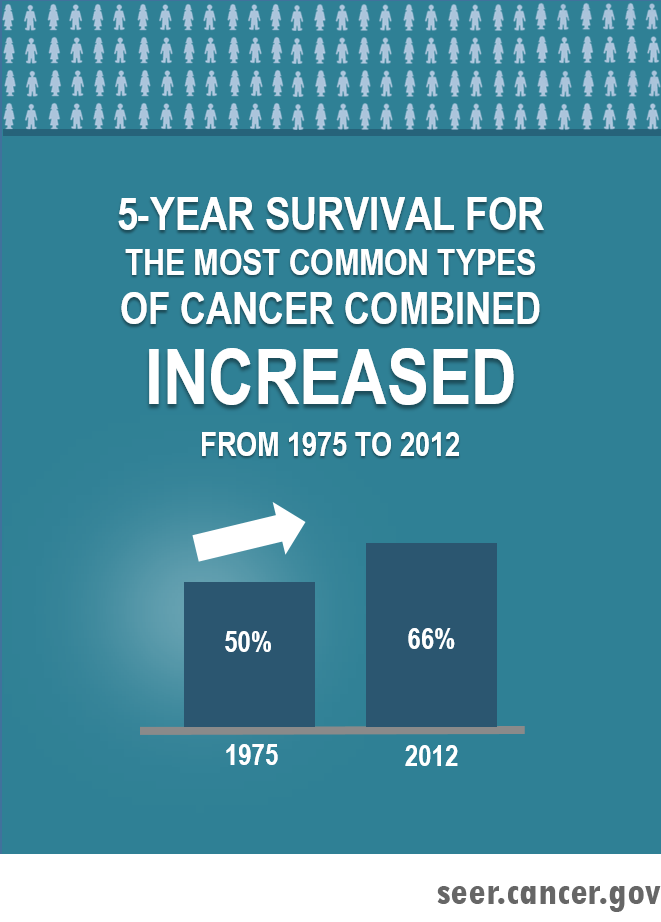As part of its Annual Report to the Nation on the Status of Cancer for 1975-2014, a group of organizations and agencies identified significant increases in cancer survival in the United States, with survival rates more than doubling for eight cancers.
The American Cancer Society, Centers for Disease Control and Prevention, National Cancer Institute, and North American Association of Cancer Registries collaborated on the report, which was issued on March 31, 2017. The annual report covers incidence and mortality trends, as well as a special feature section, which for 2017 was population-based survival by stage, race and ethnicity, and state for common cancers.

Cancer Incidence Decreases for Men, Remains Stable for Women, Increases in Children
The group looked at data from 1999–2013 to determine cancer incidence rates. During that time period, overall incidence rates for men decreased 0.6% per year from 1999–2008 and 2.3% per year from 2008–2013. Incidence rates for women remained stable during the same 15-year time period.
By cancer type, incidence decreased for 7 of the 17 most common cancers in men and 7 of the 18 most common cancers in women, including lung and colorectal cancers. However, incidence rates increased for seven cancers in men and nine cancers in women, including liver, oral cavity, pancreatic, and thyroid cancers as well as myeloma and melanoma.
Additionally, women saw a 0.4% increase in breast cancer incidence per year over the past five years. In children, where the rates were divided by ethnic group, incidence rates increased by 0.4%–1% per year from 2009–2013 except in American Indian/Alaska Native groups.
The collaborative group cautioned that the findings must be interpreted in context, depending on the reason for the decrease or increase in incidence rates. Decreases that occur because Americans are improving modifiable risk factors or increasing use of screening tests to detect (and remove precancerous lesions, such as with colorectal screening) are good news. However, decreased incidence rates from drops in screening rates may cause some cancers to be diagnosed at advanced stages that are more difficult to treat.
Cancer Mortality Decreases Across All Major Groups
The group looked at data from 2000–2014 to determine cancer death rates. From 2010–2014, overall mortality rates decreased for 11 of the 16 most common cancers in men and 13 of the 10 most common cancers in women, including lung, colorectal, female breast, and prostate cancers. The trend was similar across racial and ethnic groups, except for stable mortality rates for breast cancer in Hispanic women, lung and colorectal cancer in American Indian/Alaska Native men, and colorectal cancer in Asian Pacific Islander and American Indian/Alaska Native women. Mortality rates did increase for liver cancer in men and women, pancreatic and brain cancer in men, and uterine cancer in women.
Among children, mortality rates decreased by 1.5%–2.6% across all racial and ethnic groups, although the rates could not be calculated for American Indian/Alaska Native groups because of sparse data.
As with incidence rates, the collaborative group provided context for interpreting the mortality rates reported. It reminded that the data provided are rates based on the number of deaths per 100,000 Americans. Although overall mortality rates are decreasing, actual number of deaths may increase because of increases in overall population size and the number of older Americans.

Five-Year Survival Increases Significantly for All But Two Cancer Types
For all patients diagnosed between 1975–1977 and 2006–2012, five-year survival increased significantly for all cancers except cervical and uterine. Survival rates improved substantially for both early and late stages for most types.
Prostate and kidney cancers as well as non-Hodgkin lymphoma, myeloma, and leukemia saw the highest absolute changes (25% or greater), whereas esophageal, stomach, pancreatic, and liver cancer as well as myeloma saw the highest proportional changes (100% or greater).
Cancers with the highest five-year relative survival rates were prostate (99.3%), thyroid (98.3%), melanoma (93.2%), and female breast (90.8%). Those with the lowest rates were pancreatic (8.5%), liver (18.1%), lung (18.7%), esophagus (20.5%), stomach (31.1%), and brain (35%). For five-year absolute gain in survival rates, although the gain seems small (less than 10%), when translated in proportionate terms, the survival rates more than doubled for eight cancers.
Childhood cancers also saw substantial improvements in five-year survival, ranging from an absolute increase of 16.8% for Hodgkin lymphoma to 48.3% for acute myeloid leukemia.
Racial and ethnic disparities were found: an adjusted relative risk of death for all cancers combined was 33% higher in non-Hispanic African Americans and 51% higher in non-Hispanic American Indian/Alaska Natives compared to non-Hispanic Caucasians. Geographic disparities also existed: survival for common cancers (e.g., colorectal, female breast) was lowest in certain Southern and Midwestern states and highest in Northeastern states.
Improved survival rates have implications for oncology nursing, such as facilitating survivorship care planning and good hand-off care to primary care and other specialties to ensure continued surveillance for cancer prevention. ONS is working to prepare the future nursing workforce, including those in non-oncology settings, to care for cancer survivors.






